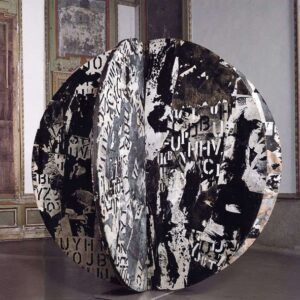
Plurimi
Loretta Pettinato
(Translated by Laura Pettinato)

The artist Emilio Vedova, born in 1919, was able to renovate the artistic language of his time thanks to his brilliant madness and extraordinary instincts.
Palazzo Reale celebrated the centenary of his birth by setting up a retrospective of his art which, through constant research and experimentation, morphed from an original realism to a geometric and abstract style consisting of lines, different levels and volumes through space.
The Sala delle Cariatidi, with its solemn and majestic atmosphere, enhanced Vedova’s work, especially the dynamism and explosive energy that earned him the sobriquet ‘the Venetian Pollock’. The display encouraged visitors to feel as if they were on stage; grand artworks surrounded the space, installed on the floor or on the walls, furrowed by frenetic yellow, black, gray and red brushstrokes. The impact was breath-taking. One could almost feel the artist’s anger as he furiously painted on the canvases unravelling onto the floor.
A wall divides the room: one side focuses on the paintings and sculptures created in the 1940s and 1970s, such as the Plurimi, the other on the pieces created during the 1980s and 1990s, like the Dischi. He started working on the Plurimi in 1963; using collages and graffiti, he created paintings on wooden structures of different sizes and shapes, connected by iron hinges, which allow the compositions to open like theater stages. In 1964 he brought to life the colorful Plurimi of the “Absurdes Berliner Tagebuch” cycle.
During the 1980s and 1990s he worked on the Dischi: large wooden pieces, painted on two sides with interweaving brushstrokes that almost look like black and gray spider webs, crossed by red lightning and various material inserts. In 1993 he created ‘Who burns a book burns a man’, a big ‘disco’ consisting of four wooden crescent moons on an iron base, connected by hinges and covered with a collage of burnt fabric, paper and ash.
The artwork was intended to be an outcry against the violence of the Serbian army which, during the civil war, burnt more than one million books in Sarajevo. Vedova considered art a privileged way to denounce social tensions and injustices, to shake people’s consciences and to stand up against every kind of abuse and oppression. The titles of his most famous creations are emblematic: Clash of Situations, Cycle of Protest, Le Mani Addosso. These do not represent objects, but rather concepts and conflicting situations.
Being an eclectic artist, he moved through different mediums, experimenting with metal and glass manufacturing and engaging in graphic design. Nevertheless, painting was his main interest. Vedova didn’t become a painter, he was born one. He wrote in his diary: “when I was a child (in grade two or three) I used to go to San Marco’s Square to scrape the paint from the palettes of the artists who worked with different materials, then I would go back home and paint with my fingers.”
A free spirit and a rebel, he passionately took part in the social conflict going on at the time in order to defend civil rights, always staying true to himself and his beliefs. He died in 2006.
Emilio Vedova, Palazzo Reale – Milan, 6 December 2019 – 9 February 2020
Volume 34 mo 5 May / June 2020

